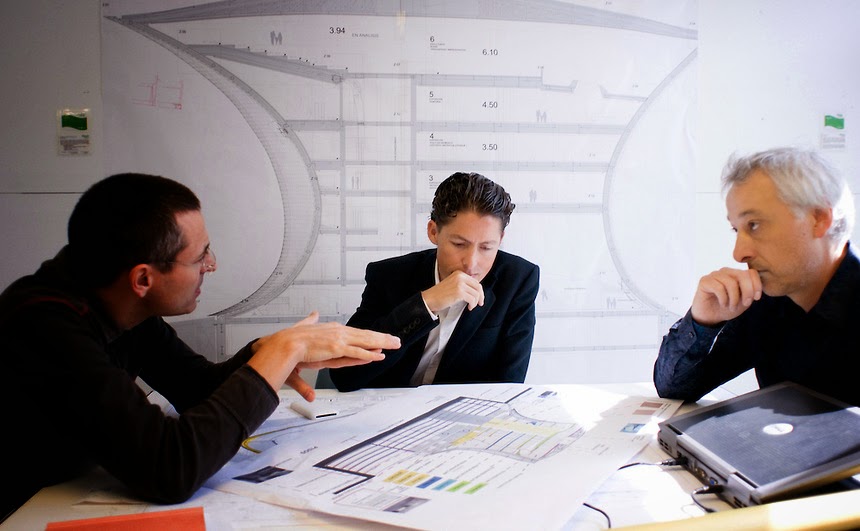LATIN AMERICAN ART MUSEUM FOR MIAMI DESIGN BY
FREE – FERNANDO ROMERO ENTERPRISE
LATIN AMERICAN ART MUSEUM FOR MIAMI DESIGN BY
FREE – FERNANDO ROMERO ENTERPRISE
President Barack Obama’s recent decision to reform US
immigration policy, FR-EE / Fernando
Romero Enterprise has released designs for a new Latin American
Art Museum (LAAM) in Miami.
The four-story museum, characterized by elongated, cantilevering terraces
and sculpture gardens, hopes to become “the most significant institution
for displaying Latin American art in America.”
From the architect:
For the last 15 years, Miami has experienced a boom, evident
in the architectonic explosion and other initiatives, such as Art Basel Miami Beach, which has seduced the international
audience since 2002.
Today, Miami is some sort of lab in which global tendencies
converge with local characteristics. Miami’s peculiar rise translates in a high
life quality. The public services have been a temptation for people who are
thinking about relocating or establishing a second place, as well as a standard
destination for international tourists.
In this historical socio-political context, the proposal for
a new museum for Latin American art is a trigger to renovate the relations with
the USA, and it also constitutes an unbeatable chance to rethink the
significance of Latin American architecture and art in America.
PROJECT
LAAM is going to be situated within a residential complex,
so it will work as the main access to the people living in the 111 apartments,
which are going to be built later. The idea behind this conception is to offer
something we could call “aesthetical quality life”. Thus the museum going to be
a sort of meeting point for the residents and their visits.
In order to translate this context, Fernando Romero has
proposed a building generous in terraces and open spaces to transfer the
exterior context into the building. The terraces of the different floors can
indeed be called “sculptural gardens”, since they will contain the art pieces
at open air. This will emphasize the benefits of the tropical architecture,
such as natural air circulation, access to open spaces, foliage and the
presence of the sea and the sun. The terraces will also spark off the curiosity
of the neighbors and the pedestrians strolling in Biscayne Boulevard, so it
will also work as an invitation to visit the museum.
The different levels of the building define LAAM’S program.
The first floor will be reserved to young and emergent artists; the second one
will be for temporal exhibitions; the third floor will house a selection of 600
pieces belonging to the permanent collection; finally, a restaurant will crown
the top of the building.
LAAM will not only be a flexible platform for the promotion
of Latin American modern and contemporary art, but also its best ambassador in
Miami: a venue where young and emerging artists will find an appropriate
atmosphere, where tourists and locals will be able to discover the new artistic
proposals and where the fans will have the chance of discovering one of the
most ambitious collections of Latin American art. The aim is to transform LAAM
into the most significant institution for displaying this art in America. It
will be completely focused on promoting its knowledge through a continuous
process of appreciation and reinterpretation of Latin American art and its
diaspora.
http://www.archdaily.com/574602/fr-ee-fernando-romero-enterprise-reveals-latin-american-art-museum-for-miami/
ANTONIO MALTA CAMPOS
Figures in Red 2004 No: 2
Dimensions: 230 * 360
LATIN AMERICAN ART MUSEUM FOR MIAMI
ANTONIO MALTA CAMPOS
Figures in Red 2004
Dimensions: 230 * 360
ANTONIO MALTA CAMPOS
Black & Blue 2007
Acrylic on Canvas
Dimensions: 230 * 360
LATIN AMERICAN ART MUSEUM FOR MIAMI
ANTONIO MALTA CAMPOS
Things 2004
Acrylic on Canvas
Dimensions: 230 * 360
FERNANDO ROMERO
Fernando Romero was trained in Europe before founding FR-EE,
a platform of multidisciplinary exchanges, which translates the contemporary
culture through all fields of design, considering architecture its epicenter.
He has taught at Columbia University, published several books and received a
number of international awards. He lives between NY and Mexico.
FR-EE is an active agent in the reconfiguration of urban and
public space by means of translating historical and social context into a
unique architectural language.
http://fr-ee.org/about/







































